
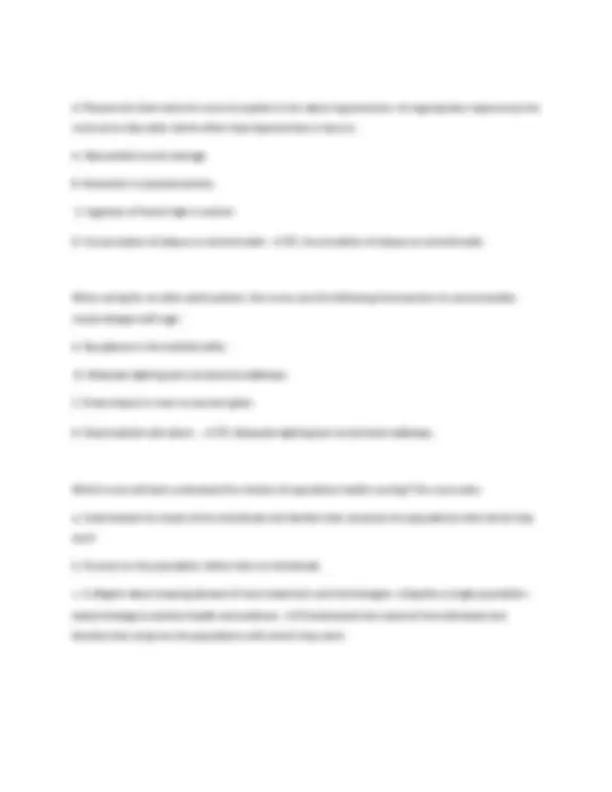
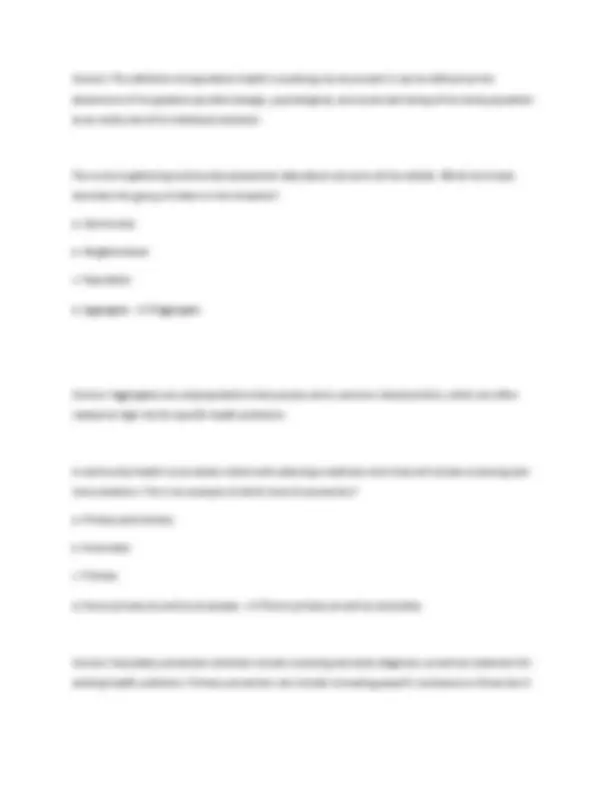
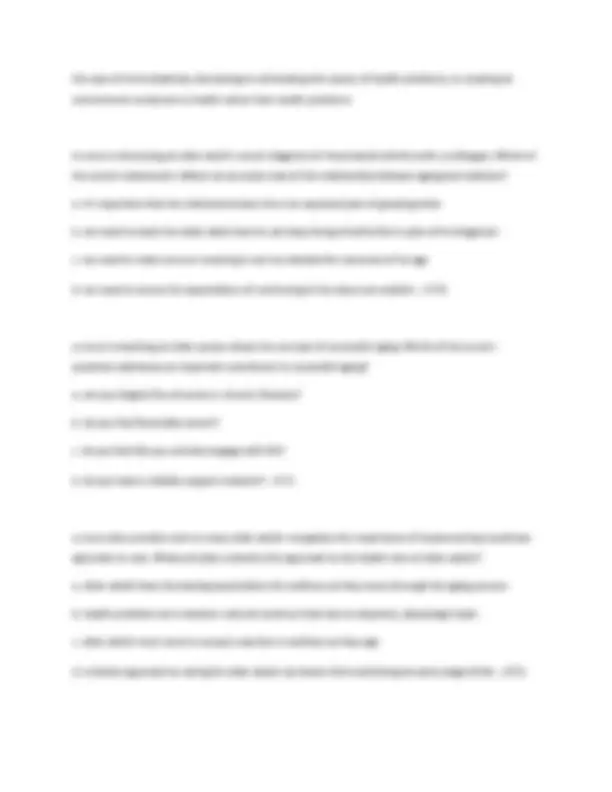
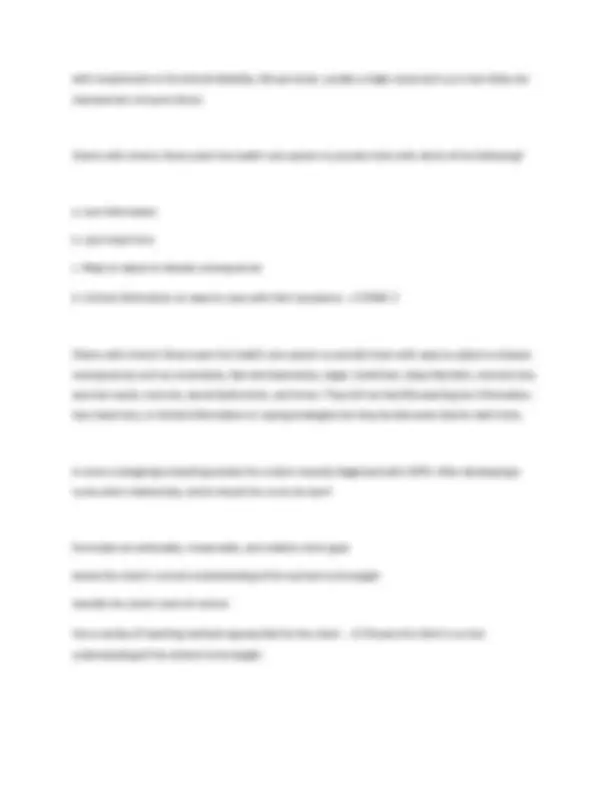
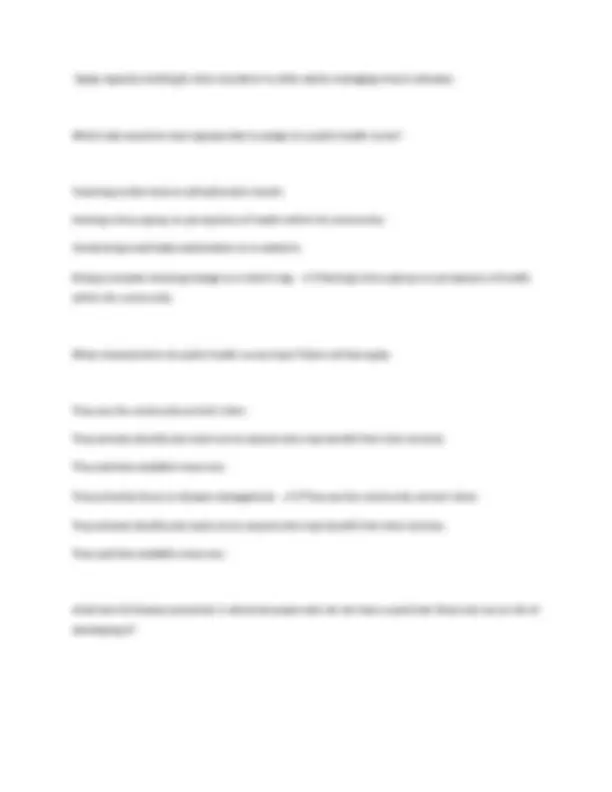
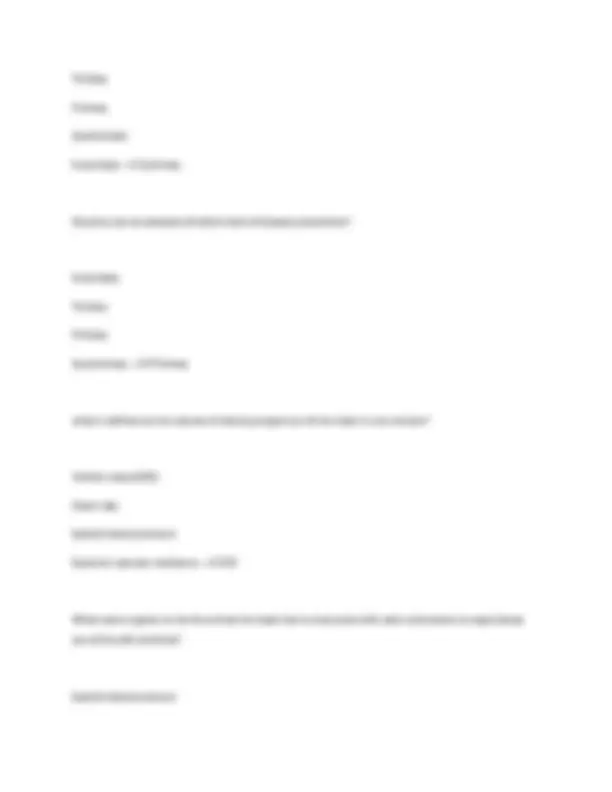
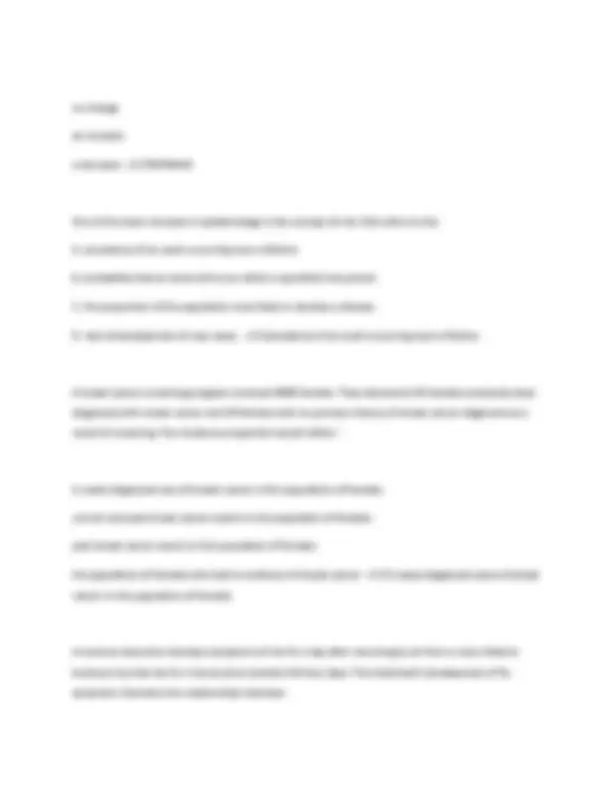
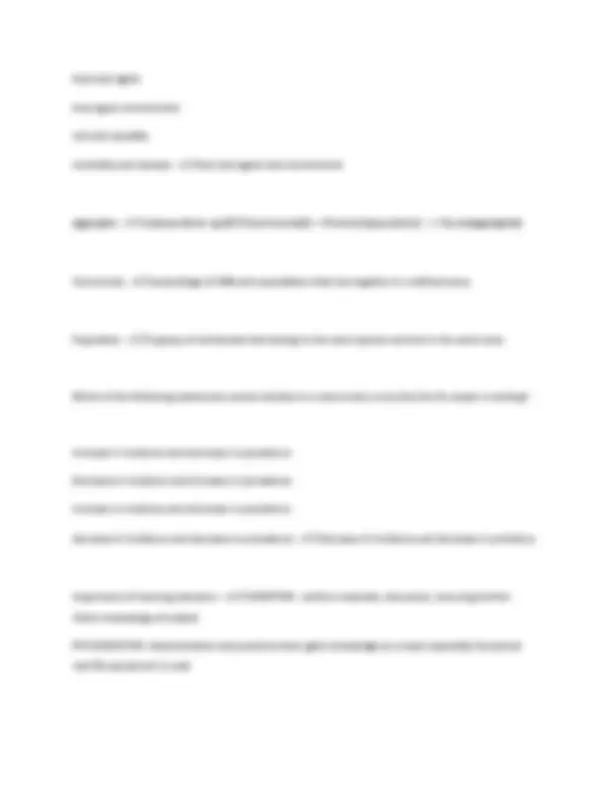
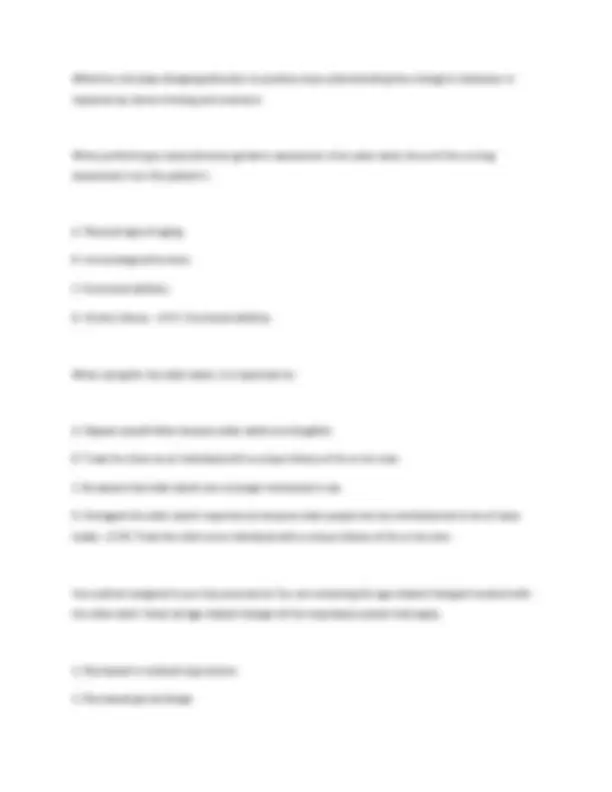
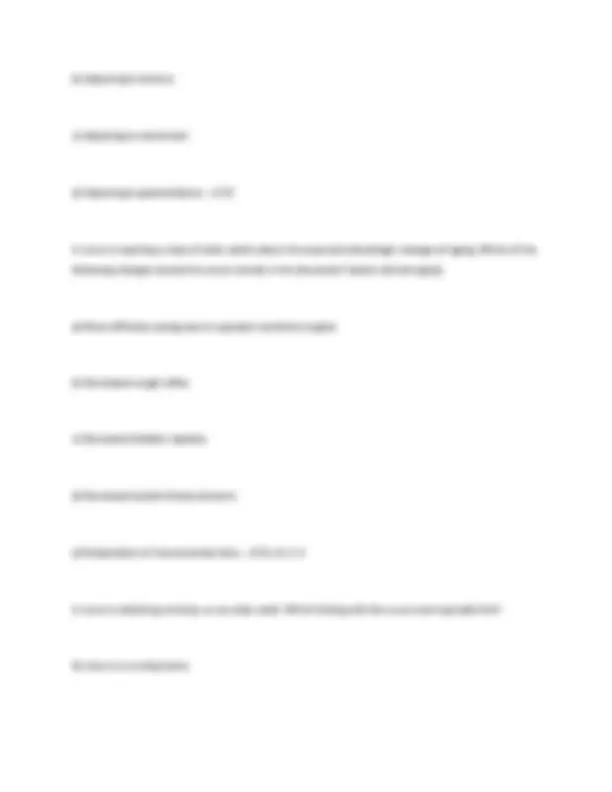
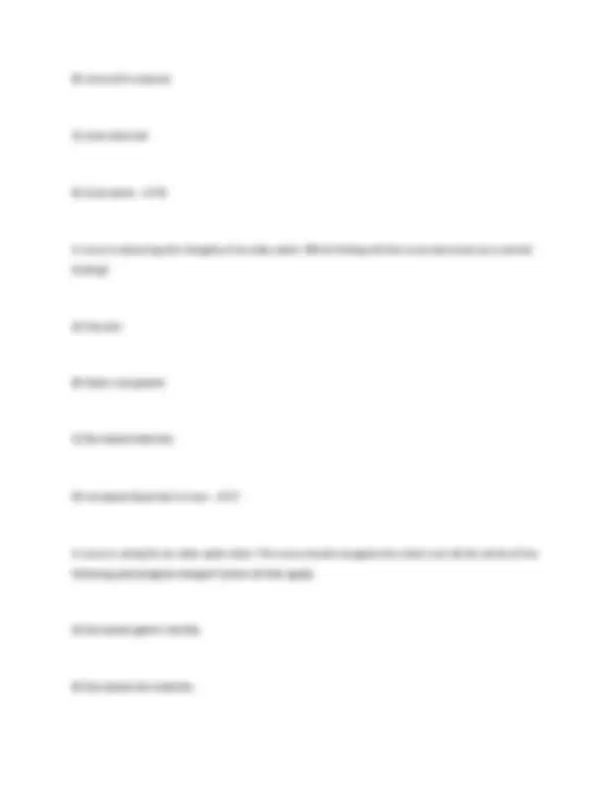
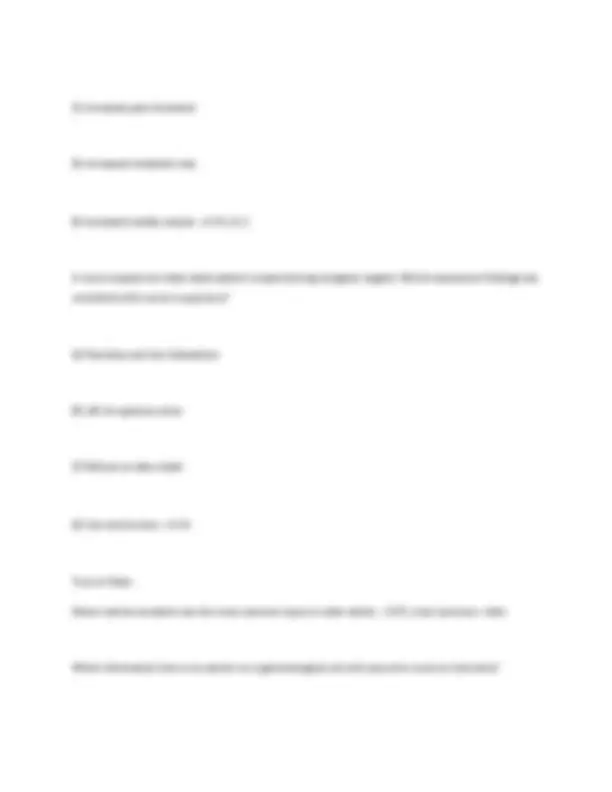
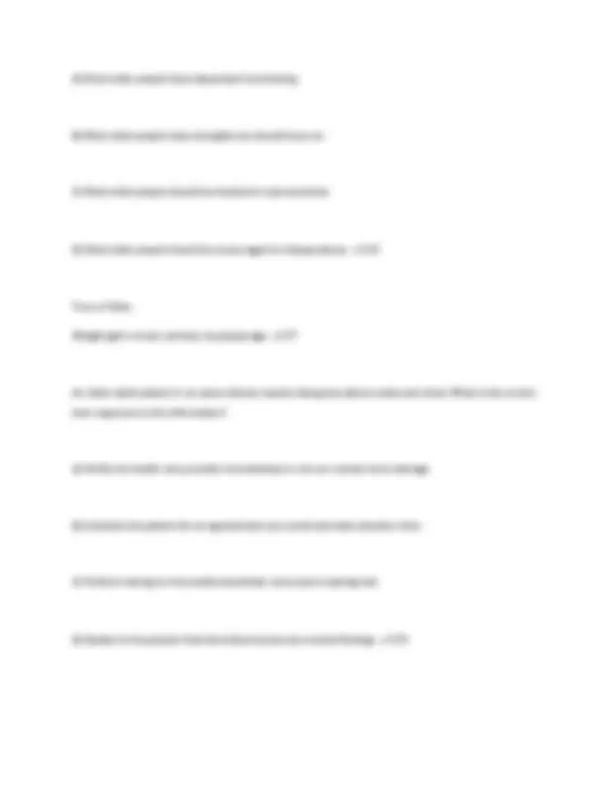
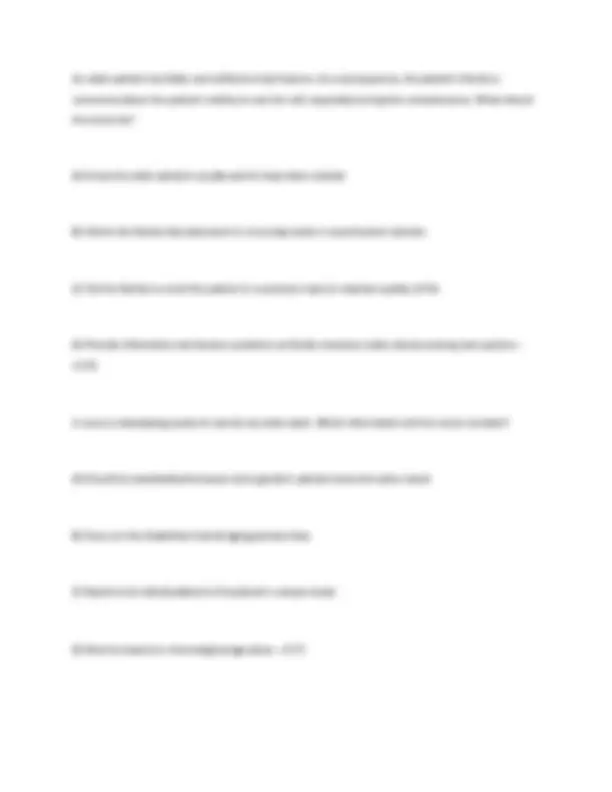


Study with the several resources on Docsity

Earn points by helping other students or get them with a premium plan


Prepare for your exams
Study with the several resources on Docsity

Earn points to download
Earn points by helping other students or get them with a premium plan
Community
Ask the community for help and clear up your study doubts
Discover the best universities in your country according to Docsity users
Free resources
Download our free guides on studying techniques, anxiety management strategies, and thesis advice from Docsity tutors
BSNC 1000 midterm Exam with Verified solutions| Rated A+
Typology: Exams
1 / 22

This page cannot be seen from the preview
Don't miss anything!















The world health organization now defines health as a. A way of life for individuals and people b. The absence of disease or infirmity c. The ability to function in a new environment d. Complete physical, mental and social wellbeing - ✔✔d. Complete physical, mental and social wellbeing Primary prevention activities include one of the following a. Retraining to maximize remaining capacities b. Prompt treatment after early diagnoses c. Treatment to arrest the disease process d. Health education and promotion of wellness - ✔✔d. Health education and promotion of wellness Immunization and water purification are examples of a.Intermediate prevention b. Primary prevention c. Secondary prevention d. Tertiary prevention - ✔✔b. primairy prevention Which of the following is an example of high-level wellness?
Following and imposing physical training regimen for someone else's benefit Managing one's chronic illness while living a happy life by doing the most one can Recovering quickly from a broken arm or leg in a hospital environment Keeping up a level of perfect physical health at a community center - ✔✔Managing one's chronic illness while living a happy life doing the most one can You are caring for a 78 year-old female cardiac patient. In preconference, your clinical instructor asks you what is an age-related change in the cardiac system of the older adult?
Correct: The definition of population health is evolving, but at present it can be defined as the attainment of the greatest possible biologic, psychological, and social well-being of the total population as an entity and of its individual members. The nurse is gathering community assessment data about concerns of the elderly. Which term best describes the group of elders in this situation? a. Community b. Neighborhood c. Population d. Aggregate - ✔✔Aggregate Correct: Aggregates are subpopulations that possess some common characteristics, which are often related to high risk for specific health problems. A community health nurse assists clients with planning a wellness clinic that will include screening and immunizations. This is an example of which level of prevention? a. Primary and tertiary b. Secondary c. Primary d. Some primary as well as secondary - ✔✔Some primary as well as secondary Correct: Secondary prevention activities include screening and early diagnosis, as well as treatment for existing health problems. Primary prevention can include increasing people's resistance to illness (as in
the case of immunization); decreasing or eliminating the causes of health problems; or creating an environment conducive to health rather than health problems. A nurse is discussing an older adult's recent diagnosis of rheumatoid arthritis with a colleague. Which of the nurse's statements reflects an accurate view of the relationship between aging and wellness? a. it's important that the individual knows this is an expected part of growing older b. we need to teach the older adult how he can keep living a fruitful life in spite of his diagnosis c. we need to make sure our teaching is not too detailed for someone of his age d. we need to ensure his expectations of continuing to live alone are realistic - ✔✔b a nurse is teaching an older person about the concept of successful aging. Which of the nurse's questions addresses an important contributor to successful aging? a. are you largely free of acute or chronic illnesses? b. do you feel financially secure? c. do you feel like you actively engage with life? d. do you have a reliable support network? - ✔✔c a nurse who provides care to many older adults recognizes the importance of implementing a wellness approach to care. What principle underlies this approach to the health care of older adults? a. older adults have decreasing expectations for wellness as they move through the aging process b. health problems are a western cultural construct that has no objective, physiologic basis c. older adults must come to accept a decline in wellness as they age d. a holistic approach to caring for older adults can foster their well-being at every stage of life - ✔✔d
Poverty and socioeconomic disadvantage are recognized to have a major impact on the development of chronic illness. Social stability, urban living, and having a high school education are not factors contributing to the development of chronic illness. Which of the following statements is true related to nonmodifiable risk factors for chronic illness? a. Cannot be changed b. Requires intervention in order to change c. Can be altered to benefit health outcomes d. Can be changed with client perseverance - ✔✔ANS: A Nonmodifiable risk factors cannot be changed. Requiring intervention in order to change, altering, and changed with perseverance all indicate that change is possible. Which of the following characteristics is true related to chronic illness? a. Abrupt onset b. Usually single cause c. Short latency period d. Noninfectious origin - ✔✔ANS: D Chronic (or noncommunicable) illnesses are typically characterized as having an uncertain etiology, multiple risk factors, long latency, prolonged duration, and a noninfectious origin and can be associated
with impairments or functional disability. Abrupt onset, usually a single cause and cure most likely are characteristic of acute illness. Clients with chronic illness want the health care system to provide them with which of the following? a. Less information b. Less travel time c. Ways to adjust to disease consequences d. Limited information on ways to cope with their symptoms - ✔✔ANS: C Clients with chronic illness want the health care system to provide them with ways to adjust to disease consequences such as uncertainty, fear and depression, anger, loneliness, sleep disorders, memory loss, exercise needs, nocturia, sexual dysfunction, and stress. They did not identify wanting less information, less travel time, or limited information on coping strategies but they do also want shorter wait times. A nurse is designing a teaching session for a client recently diagnosed with COPD. After developing a nurse-client relationship, which should the nurse do next? Formulate an achievable, measurable, and realistic client goal. Assess the client's current understanding of the content to be taught. Identify the client's level of control. Use a variety of teaching methods appropriate for the client. - ✔✔Assess the client's current understanding of the content to be taught.
Tertiary Primary Quarternary Secondary - ✔✔primary Vaccines are an example of which level of disease prevention? Secondary Tertiary Primary Quarternary - ✔✔Primary what is defined as the volume of blood pumped out of the heart in one minute? Cardiac output(CO) Heart rate Systolic blood pressure Systemic vascular resistance - ✔✔CO What name is given to the force that the heart has to overcome with each contraction to expel blood out of the left ventricle? Systolic blood pressure
Diastolic blood pressure Systemic vascular resistance Cardiac output - ✔✔Systemic vascular resistance What are the two main components of blood pressure? Select all that apply. Cardiac output Cardiac index Stroke volume Systemic vascular resistance Blood type - ✔✔CO and SVR Which of the following best describes disease? Results in ability to perform a desrired levek Something that is individulaized is a subjective expereince of ill health Is an objective experience of ill health - ✔✔Is subjective expereince of ill health chronic disease management includes all of the following factors expect : Requires an ongoing, planned,integrated approach within an easily navigated system Invovles clients to be passive partner in managing their condition
no change an increase a decrease - ✔✔DECREASE One of the basic concepts in epidemiology is the concept of risk. Risk refers to the: A. prevalence of an event occurring over a lifetime B. probability that an event will occur within a specified time period. C. the proportion of the population most likely to develop a disease. D. rate of development of new cases. - ✔✔prevalence of an event occurring over a lifetime A breast cancer screening program screened 8000 females. They discovered 35 females previously been diagnosed with breast cancer and 20 females with no previous history of breast cancer diagnosed as a result of screening. The incidence proportion would reflect : A newly diagnosed case of breast cancer in this population of females current and past breast cancer events in this population of females past breast cancer events in this population of females the population of females who had no evidence of breast cancer - ✔✔A newly diagnosed cases of breast cancer in this population of females A business executive develops symptoms of the flu 1 day after returning by air from a cross-Atlaninc business trip that ran for 2 consecutive stressful 10-hour days. This individual's development of flu symptoms illustrates the relationships between:
Host and agent host agent environment risk and causality morbidity and disease - ✔✔host and agent and environment aggergate - ✔✔subpopulation eg (BCIT(community)))--->Students(population) ---> Nurse(aggregate)) Community - ✔✔assemblage of different populations that live together in a defined area Population - ✔✔A group of individuals that belong to the same species and live in the same area Which of the following statements would indicate to a community nurse that the flu season is ending? Increase in incidence and decrease in prevalence Decrease in incidence and increase in prevalence Increase in incidence and decrease in prevalence decrease in incidence and decrease in prevalence - ✔✔decrease in incidence and decrease in prevlance Importance of learning domains: - ✔✔COGNITIVE: - written materials, discussion, lecturing-further clients knowledge of subject PSYCHOMOTOR:-demonstration and practice-client gains knowledge on a topic especially if practical real life equipment is used
legs. Based on your nursing knowledge and the patient's symptoms, you suspect the patient suffers from what type of COPD? A. Emphysema B. Pneumonia C. Chronic bronchitis D. Pneumothorax - ✔✔C. Chronic bronchitis A nurse is teaching a group of older-adult patients. Which teaching strategy is best for the nurse to use? a) Provide several topics of discussion at once to promote independence and making choices b) Avoid uncomfortable silences after questions by helping patients complete their statements c) Ask patients to recall past experiences that correspond with their interest d) Speak in high pitch to help patients hear better - ✔✔C A nurse is caring for an older adult. Which goal is the priority? a) Adjusting to career
B) Lives with a spouse C) Lives divorced D) Lives alone - ✔✔B A nurse is observing skin integrity of an older adult. Which finding will the nurse document as a normal finding? A) Oily skin B) Faster nail growth C) Decreased elasticity D) Increased facial hair in men - ✔✔C A nurse is caring for an older adult client. The nurse should recognize the client is at risk for which of the following physiological changes? (select all that apply) A) Decreased gastric motility B) Decreased skin elasticity
C) Increased pain threshold D) Increased metabolic rate E) Increased cardiac output - ✔✔A, B, C A nurse suspects an older-adult patient is experiencing caregiver neglect. Which assessment findings are consistent with nurse's suspicions? A) Flea bites and lice infestations B) Left at a grocery store C) Refuses to take a bath D) Cuts and bruises - ✔✔A True or False: Motor vehicle accidents are the most common injury in older adults - ✔✔F; most common = falls Which information from a co-worker on a gerontological unit will cause the nurse to intervene?